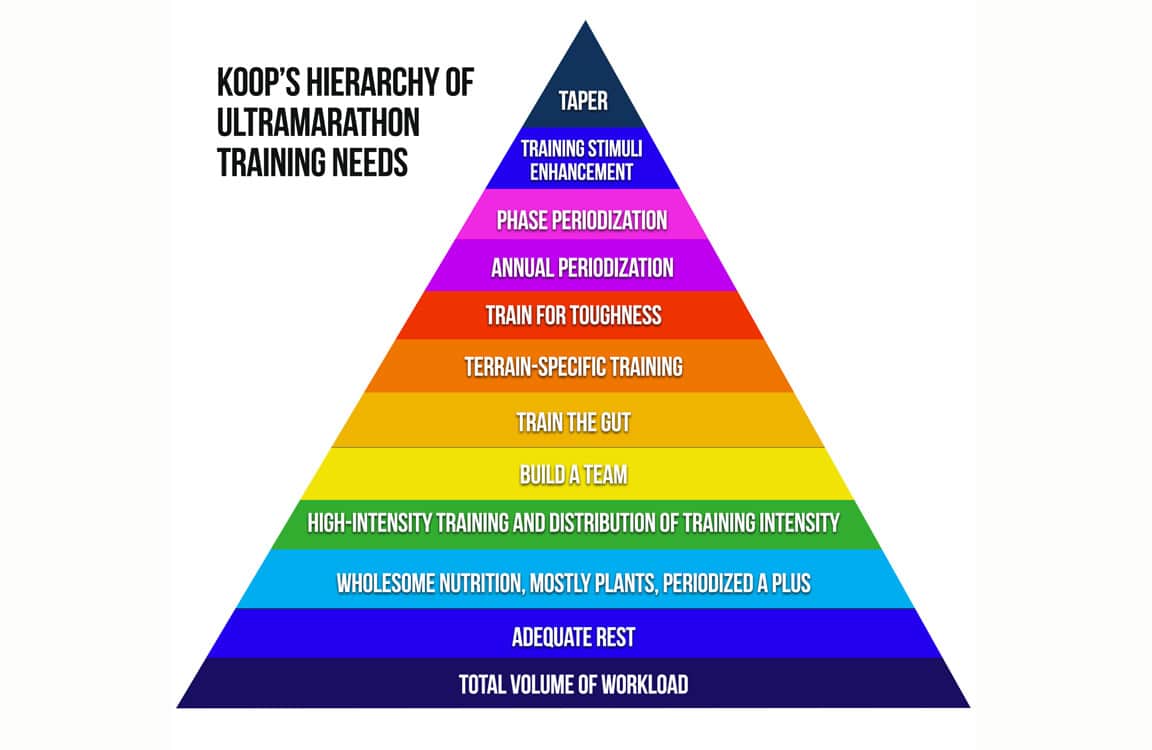
The Hierarchy of Ultramarathon Training Needs
My alma matter’s Code of Conduct was “Aggies do not lie, steal or cheat, nor do they tolerate those that do”. As we A&M Aggies are a cheeky lot, we would routinely add an addendum to the Code that stated: “They just exaggerate, collaborate and borrow”. Little did I know in my late teens and early 20’s that the ‘collaborate and borrow’ tongue-in-cheek piece would actually come in handy as I became a professional coach.
A Hierarchy of Needs
In a 1943 paper, Abraham Maslow described human beings’ basic needs and arranged them in a hierarchy, proposing that some basic needs (food, water, security) have to be met before “higher” needs (social relationships, ego, self-esteem) are addressed. Maslow’s “Hierarchy of Needs” has been taught in psychology classes and re-envisioned for other purposes for decades. As a student of sports science, I was enthralled by Dr. Stephen Seiler’s application of this concept to physical training. He refers to the pyramid below as the “Hierarchy of Training Priorities for Endurance Athletes”.
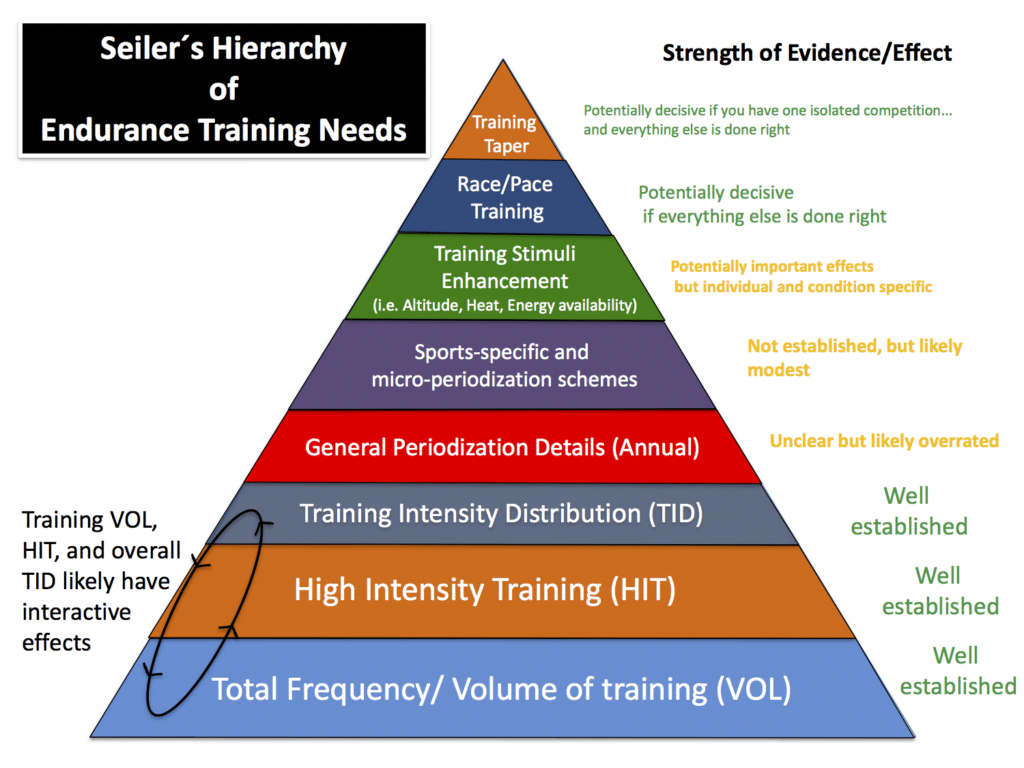
The basic premise of Seiler’s hierarchy is that athletes need to accumulate a lot of training time, and lots of time-at-intensity below and around lactate threshold, before adding more specialized techniques. I completely agree, and have preached the notion of “first things first” for years: Go after the big 20% performance gains from hours of fundamental endurance training before you try to nuance a 1-2% improvement from “marginal gains”. Don’t add altitude training until you’ve done the work to develop your aerobic engine first.
As a coach, I felt we needed to ‘collaborate and borrow’ Dr. Seiler’s hierarchy a step further. While his hierarchy describes the priorities that must be addressed to increase athletic performance, I think there is a separate hierarchy that describes the priorities needed for ultramarathon athletes, and coaches working with them, to reach their full potential.
Koop’s Hierarchy of Ultramarathon Training Needs
Athletes are not science experiments and they are not machines. Human physiology can be predicted and measured using various formulas, equations, and tests, human performance cannot. There’s no equation for mental toughness. There’s no formula for learning to adapt when Plan A, Plan B, and Plan C all go out the window. I’ve always said coaching is a combination of art and science, and when I view the concept of a hierarchy of needs through an ultramarathon coaching lens, here’s what I come up with:
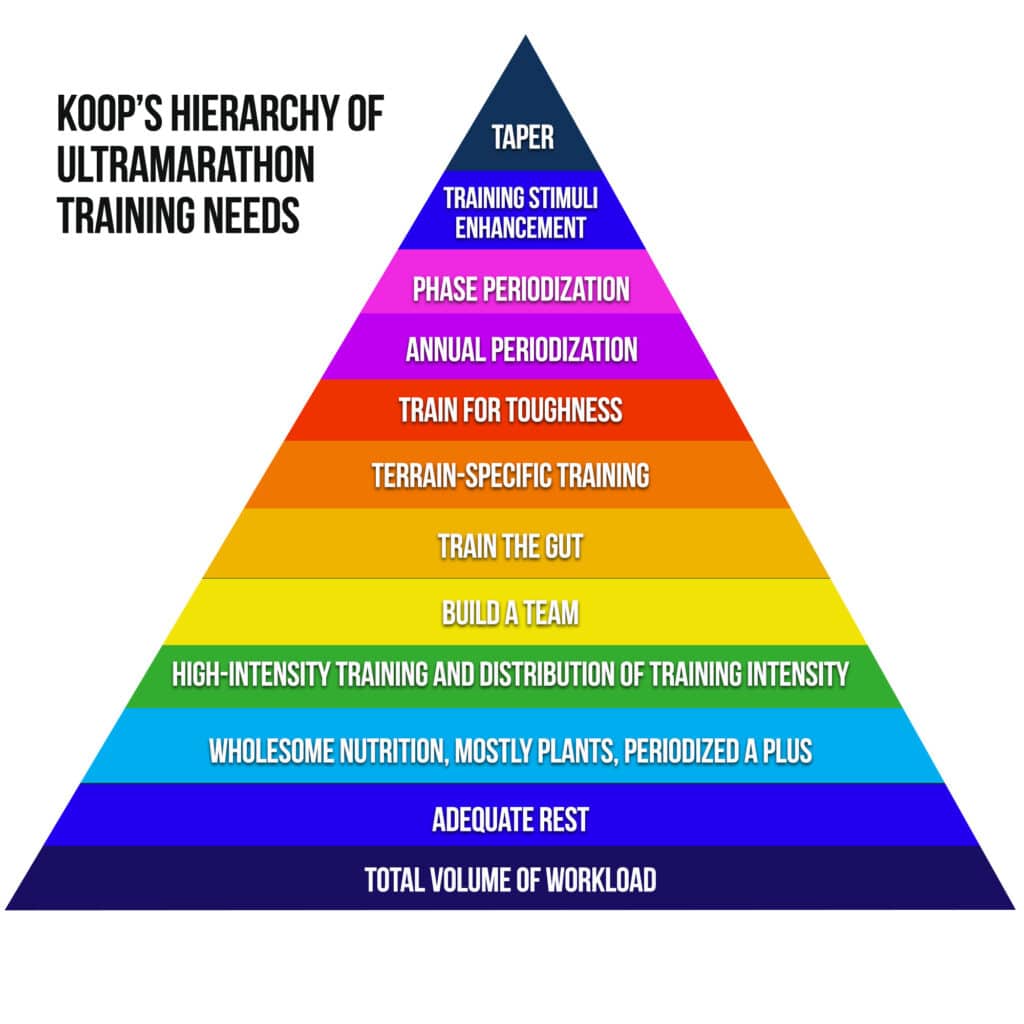
Total Volume of Workload
As with Seiler’s hierarchy, the first thing athletes have to do is put in the time. If you ask me what you should do to improve your performance, I’ll almost always say “train more over long periods of time”. The over long periods of time piece is important, because it de-emphasizes the single long run or single week volume in favor of annual volume, which is far more impactful and mitigates injury. From a coaching perspective, this means helping athletes find or create more training volume throughout the year. We try to increase the number of sessions per week, or overall number per month.
For Time-Crunched Athletes who can’t increase total weekly hours or the number of training sessions per week, I try to make some runs longer. Longer runs are helpful for generating a bigger stimulus, and for people with tight schedules I sometimes reduce the number of runs per week by consolidating two shorter training sessions into one longer run. They get the same number of hours per week, but rearranged to add duration to an individual session(s).
Adequate Rest
Rest is implicitly included in Seiler’s hierarchy because it is integral to structuring training, but I break it out into a distinct coaching need because it is typically harder to get athletes to rest than it is to get them to go full gas during an interval workout. Rest is boring, and high-energy, driven athletes have trouble taking it easy. But when I asked a roundtable of CTS Coaches the number one thing they wished their athletes would do more, it was rest.
Wholesome Nutrition, mostly plants, periodized a plus
If an athlete is putting in the time and following the plan in terms of work and recovery, a coach has to make sure they’re fueling to meet the demands of training. The foodstuff you ingest literally becomes the machinery in your body that propels you forward. I don’t preach any particular diet. Vegan athletes can be as successful as Paleo, and strict Keto is the only thing I wish athletes would stop doing (they always stop once they realize it’s not working, but it wastes time). The most important guidelines I try to reinforce with endurance athletes are:
- Consume adequate energy: What you eat only matters once you’re meeting your energy needs for training and recovery.
- Eat more plants and fewer animals: You don’t have to be vegan or vegetarian, but adding more plants is a good move. There’s nothing wrong with animal protein, but you can get all you need from plants, too.
- Don’t be afraid of carbohydrates. Consume more fresh fruit and vegetables, and save concentrated carbohydrate sources like grains for times when energy expenditure from training is highest.
- Periodize nutrition. Your training volume and intensity change during the year and your caloric intake – and your food choices to a lesser extent – should change, too.
High Intensity Training and Distribution of Training Intensity
High intensity training is an important component of training for endurance athletes – even ultraendurance athletes – but from the time-at-intensity standpoint it actually accounts for maybe 20% of training sessions and only about 10% of total training hours per year. If you run 10 hours a week (600 minutes), you’d have to average 60 minutes of work above lactate threshold just to hit 10%. Even as a coach known for – and sometimes criticized for – using VO2 max interval workouts with ultramarathon runners, the actual distribution of training intensities is heavily weighted to low intensity training with strategic use of high intensity workouts.
The slide below comes from Dr. Seiler’s “Hierarchy of Training Priorities for Endurance Athletes” presentation (available here) and represents data from this 2006 study. It illustrates the point that even with training programs that feature high-intensity interval training, the overall distribution is heavily weighted toward lower intensities.
Build a team
There is only so much an athlete can accomplish on their own before they need to build a strong support system. This includes some or all of the following: family, friends, training partners, coach, physical therapist, massage therapist, and physician. Many athletes resist this step, thinking they are “not enough of an athlete” to warrant substantive support. As a coach, one of my roles is to help an athlete build a support network, actually utilize it, and recognize the value it delivers. I routinely build relationships with my athlete’s families and support network because I know it is all part of the big giant wheel that keeps them going. When everything is going great, it may seem unnecessary. But when everything goes sideways, athletes without an established support system get swept way off track.
Train the Gut
Gastrointestinal distress is the leading cause of DNFs in ultramarathon events, and I view that as a consequence of inadequate preparation. The gut can and needs to be trained to handle the volume of food and fluids an ultramarathoner needs to consume over a 6, 12 or 30-hour period. If you’ve done everything right in terms of training, rest, and support, you’ll be able to reach the point in an ultraendurance event where your gut may be the weakest link. If you haven’t done those other things first, you won’t last long enough in the event for your gut to be an issue.
► Free Ultrarunning Training Assessment Quiz
Take our free 2-minute quiz to discover how effective your training is and get recommendations for how you can improve.
Terrain-specific training
Kaci Lickteig is a great example of why terrain-specific training is at a relatively advanced step in the hierarchy of coaching needs. She trains in Nebraska, without access to big mountains, yet she’s won the Western States Endurance Run and other ultras with tens of thousands of feet of climbing. Spending all your time running in the mountains doesn’t automatically make you a great mountain runner, especially if your training is not addressing the fundamentals first. As a coach my goal is to put the fittest athlete on the start line, because fitness is the most important tool an athlete has to be able to adapt to the specific challenges in an event. If an athlete can match a goal event’s elevation gain and climbing in training, that’s awesome, but develop the biggest aerobic engine you can before worrying about terrain-specific training.
Training for Toughness
Elite ultramarathon runners are increasingly evenly matched in terms of fitness. You’re not going to simply run a competitor off your heels anymore. These days you have to find something beyond fitness that causes a separation, and toughness (oftentimes referred to a grit) can be one of them. Who can deal with the conditions the longest? Who can maintain the focus to run harder for longer? And who can adapt the best when conditions change unexpectedly? Toughness has very little to do with physiology, and a lot to do with sports psychology, and part of a coach’s job is to design a series of experiences that force a runner (safely) outside their comfort zone. Develop toughness in training and then leverage it in races.
Annual and Phase Periodization
In its simplest terms, periodization is the application of variety in training in order to change the stimulus. On an annual basis this means training aspects of fitness that are less specific to your goal event farther out from the event, and then training more event-specific aspects of fitness as the event draws closer. On a phase or weekly basis, this gets down to how individual workouts are arranged on days of the week. Periodization plays a role in fine-tuning an athlete’s performance for events, but coaches have to be careful not to give rigid periodization schemes more importance than they are due. When it comes to periodization, almost really is good enough.
Training Stimuli Enhancement
Training stimuli enhancement like altitude training and heat acclimatization sit near the very tippy top of the pyramid, after everything else has been done. Does altitude training work? You bet, but only if the athlete is healthy, already fit, and well rested. Is heat acclimatization important? For races in hot weather, yes. But it doesn’t take that long or that much effort to achieve most of the benefits from heat acclimatization, so it shouldn’t displace fundamental training months before your event. The trouble is, chasing improvements in this area, sometimes referred to as marginal gains, is sexier than going out for another 4x10minute TempoRun workout. And coaches fall for the appeal of marginal gains, too, often to their athletes’ detriment.
Taper
“Taper Tantrums” are real and derail many athletes right before major events. Keeping an athlete on track in the final two weeks before a major goal is perhaps a coach’s most important role, but not because of the potential 1-2% improvement in performance that might come from a perfect taper.
The more important part of the taper is not screwing up everything the athlete worked so hard to build. Every year I see runners training on the track in Chamonix in the days before UltraTrail du Mont Blanc. This is silly because it is the least event-specific activity they could do. It’s a coach’s job to prevent athletes itchy for competition from being their own worst enemies. In an ideal world, the athlete enters their taper period confident they have done all the work necessary to be at their best, and that confidence allows for relaxation and stress reduction so they go to the start line rested and ready to turn all their preparation into action.
Enjoying This Article? Get More Free Running Training Tips
Get our coaches' best training advice, delivered straight to your inbox weekly.
Last Word
Athletes rarely achieve breakthrough performances purely because of their physical training. Getting an athlete to the start line with the best possible conditioning is hugely important, but it’s not everything. To realize your full potential you have to go to the start line with a full toolbox of mental, physical, and emotional tools so you are as prepared as possible to deal with the unpredictable nature of endurance sports. Your best day doesn’t happen because you have the highest VO2 max or because you have optimized fat oxidation; it happens because you have prepared yourself for whatever a race can throw at you and you have prepared more for the things that matter more.
By Jason Koop,
Head Coach of CTS Ultrarunning
References:
https://www.researchgate.net/publication/310725768_Seiler’s_Hierarchy_of_Endurance_Training_Needs
Seiler, K. Stephen, and Glenn Ovrevik Kjerland. “Quantifying Training Intensity Distribution in Elite Endurance Athletes: Is There Evidence for an ‘Optimal’ Distribution?” Scandinavian Journal of Medicine and Science in Sports, vol. 16, no. 1, 2006, pp. 49–56., doi:10.1111/j.1600-0838.2004.00418.x.

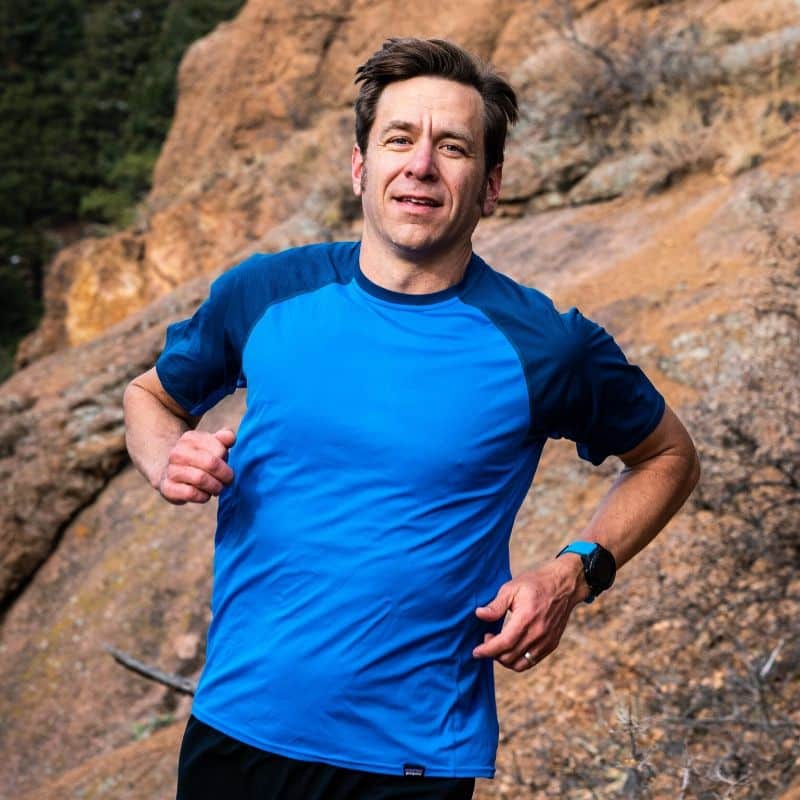
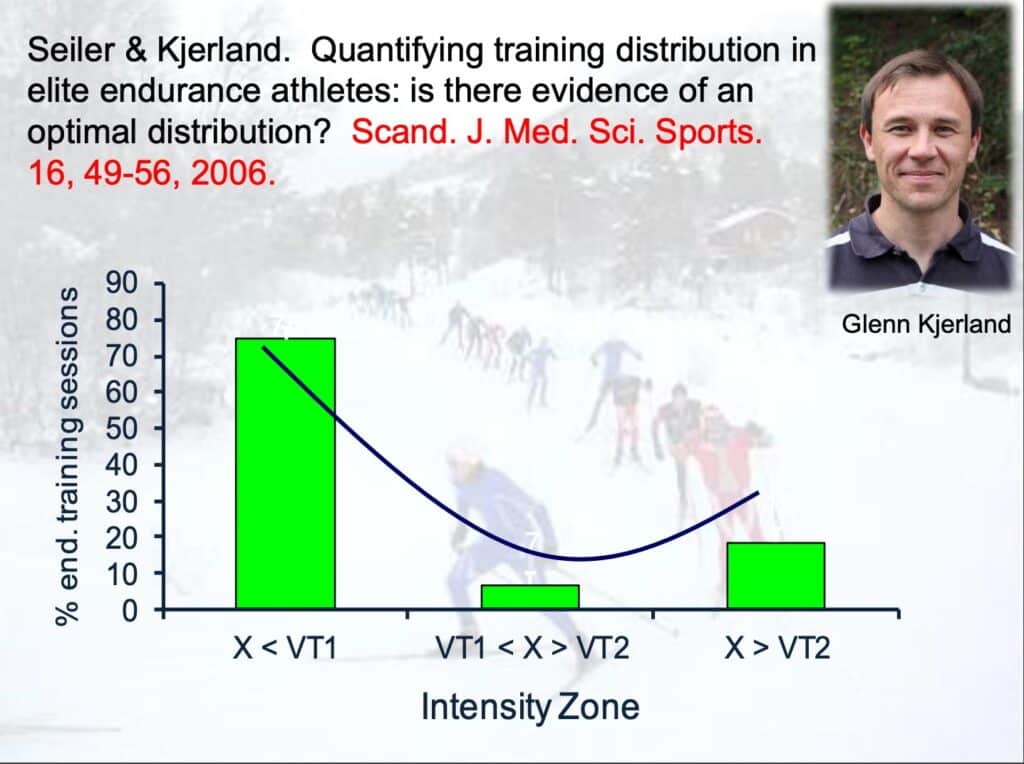
Comments 8
Pingback: Ultramarathon Daily News for Wed Apr 19 - Ultrarunnerpodcast.com
Very nice overview.
Pingback: My first trimester running report – Mallory Richard
Pingback: Superior 2019 – A post mortem – Mallory Richard
Pingback: 你有聽過超野的訓練層級金字塔嗎? - RUNIVORE
Great overview of what we need to do as athletes when we are in the midst of training. Balancing these needs appears to be the best answer…when in doubt, go back to the foundations of the sport.
Thanks for sharing this wealth of information!
What a nice article! I love the hierarchy concept. As a sports dietitian I would add someone like myself to the support team. A sports dietitian can help translate nutrition recommendations like “more plant protein” or “ample carbohydrate” into specific foods that the athlete likes and tolerates and can make suggestions to help with gut training. Thanks for an informative read! I have only worked with a couple of ultra-endurance athletes, and this expanded my knowledge.
This is wonderful.
How often is VO2 max training done – are you periodizing or sprinkling in week to week?